Daubenton's
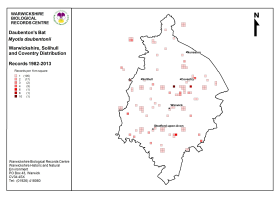
Distribution map for Daubenton's bats in Warwickshire. (Click for a full sized image)
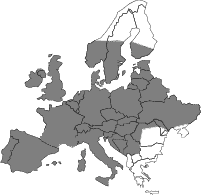 Daubenton's bat (Myotis daubentonii) is a medium-sized species. It
occurs throughout Europe up to about 63ºN, across to Korea and Japan. It
is though to be increasing in numbers in parts of Europe. In Britain it
is fairly widespread up to northern Scotland, in Ireland and the Isle of
Man.
Daubenton's bat (Myotis daubentonii) is a medium-sized species. It
occurs throughout Europe up to about 63ºN, across to Korea and Japan. It
is though to be increasing in numbers in parts of Europe. In Britain it
is fairly widespread up to northern Scotland, in Ireland and the Isle of
Man.
Despite severe loss of and damage to wetlands and waterways, Daubenton's bat
seems to be increasing in parts of its range. This may, in part, be associated
with increasing numbers of artificial water bodies, including gravel pits,
reservoirs and flooded quarries. Also a low level of pollution may encourage a
more consistent supply of certain chironomid midges.
However, the loss of
diversity of aquatic insects has a detrimental effect on other animals and
without the very careful control of pollution Daubenton's bats would be
affected. the removal of waterside trees and disturbance to hibernation sites
could also lead to a decline in this species.
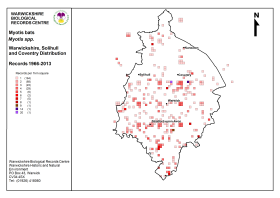
Distribution map for all species of Myotis bats in Warwickshire. (Click for a full sized image)
flight & ultrasound
It has a steady flight, often within a few centimetres of the water surface
and is reminiscent of a small hovercraft. Daubenton's bats take insects
from close to the water surface. They have even been seen taking prey
directly from the water surface, using their large feet as a gaff or the
tail membrane as a scoop. They fly at about 25kph (15mph).

They usually feed within about 6km of the roost but have been recorded
following canals for up to 10km. It is thought that they need to drink
more frequently than other species, hence the old name of 'water bat'
is quite appropriate. They often travel across land and occasionally feed
away from water.
Like most bats they can eat copious amounts of insects each night. A
7-gram Daubenton's bat often returns to its roost after an hour's feeding
weighing 11 grams. That is a 57% increase in its body weight!
Daubenton's bat ultrasound calls range from 35 - 85 kHz and peak at 45
- 50 kHz. On a heterodyne bat detector
the calls are a machine-gun like series of regular clicks for bursts of
5 to 10 seconds.
 Daubenton's recorded on a Time Expansion bat detector
Daubenton's recorded on a Time Expansion bat detector
 Daubenton's recorded on a Heterodyne bat detector
Daubenton's recorded on a Heterodyne bat detector
breeding
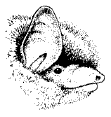 Mating
takes place in the autumn and active males will seek out females throughout
the winter. Maternity colonies, numbering between 40 to 80 bats but sometimes
exceeding 100 individuals, consist almost entirely of adult females and
are occupied from late spring sometimes until October. Young bats are
suckled for several weeks and are fully weaned and able to forage for
themselves at 6-8 weeks. Males or non-breeding females may aggregate during
the summer to form their own communal roosts but sometimes join maternity
colonies.
Mating
takes place in the autumn and active males will seek out females throughout
the winter. Maternity colonies, numbering between 40 to 80 bats but sometimes
exceeding 100 individuals, consist almost entirely of adult females and
are occupied from late spring sometimes until October. Young bats are
suckled for several weeks and are fully weaned and able to forage for
themselves at 6-8 weeks. Males or non-breeding females may aggregate during
the summer to form their own communal roosts but sometimes join maternity
colonies.
summer roosts
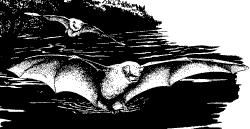 In
England and Wales, the majority of known summer colonies are in humid,
more or less underground sites near water. These may be tunnels or bridges
over canals and rivers, or in caves, mines and cellars. They are only
occasionally found in buildings, usually old stone buildings such as moated
castles and waterworks. In Scotland colonies more frequently occur in
houses. Tree holes are probably much more widely used than the recorded
evidence suggests and one individual was even observed entering a small
hole in an earthen roadside bank! They also have bred in bat boxes.
In
England and Wales, the majority of known summer colonies are in humid,
more or less underground sites near water. These may be tunnels or bridges
over canals and rivers, or in caves, mines and cellars. They are only
occasionally found in buildings, usually old stone buildings such as moated
castles and waterworks. In Scotland colonies more frequently occur in
houses. Tree holes are probably much more widely used than the recorded
evidence suggests and one individual was even observed entering a small
hole in an earthen roadside bank! They also have bred in bat boxes.
Summer colonies are often quite noisy throughout the day, especially
at sites where they are close to human activity. A variety of temporary
night roosts are used, often in trees or tunnels close to their feeding
sites. Daubenton's bats have been found clustering with Pipistrelles,
Noctules, Natterer's and Brown Long-eared bats.
winter roosts
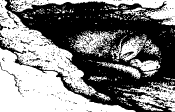 Many
Daubenton's bats hibernate in caves, mines and other underground sites.
In extensive tunnels systems with large numbers of bats present, Daubenton's
are often the most numerous. They enter these winter sites in October
but only small numbers are present in the early part of winter. Numbers
can increase dramatically towards the end of January and in February,
and individuals often remain at these sites until the end of March or
early April. Most are found in the warmer more stable environment within
a site, although they can be found close to the entrance, particularly
later in winter.
Many
Daubenton's bats hibernate in caves, mines and other underground sites.
In extensive tunnels systems with large numbers of bats present, Daubenton's
are often the most numerous. They enter these winter sites in October
but only small numbers are present in the early part of winter. Numbers
can increase dramatically towards the end of January and in February,
and individuals often remain at these sites until the end of March or
early April. Most are found in the warmer more stable environment within
a site, although they can be found close to the entrance, particularly
later in winter.
Although usually solitary, small groups of 3 or 4 are not uncommon. Individuals
are often lodged in tight crevices; many being barely visible and it is
likely that others are hidden away. They may also hide among rocks and
scree on the floor of caves and tunnels. Thus, finding Daubenton's bats
can be very difficult and it is likely that the numbers counted in many
sites are a considerable underestimate of the numbers actually present.
| Description |
|
| Head and Body Length |
45 - 55 mm |
| Forearm Length |
34 - 41 mm |
| Wingspan |
240 - 275 mm |
| Weight |
7 - 12 g |
| Colour |
Fur is red-brown, pale underneath. Pinkish face, bare around the
eyes.
|
|
|
| Life Cycle |
|
| Mating Period |
Autumn and throughout the winter. |
| Maternity Colonies |
Established late spring.
Young: 1 born end of June to early July, weaned at 6 weeks. |
| Colony Size |
20 to 50 bats (up to 200). |
| Longevity |
Up to 22 years. |
| UK Status |
Not threatened.
|
|
|
| Habitat and Food |
|
| Summer Roosts |
Trees, also tunnels, bridges, caves, mines. |
| Winter Roosts |
Caves, mines and other underground sites. |
| Feeding Habitat |
Over lakes, rivers and ponds. |
| Food |
Small flies (especially chironomid midges), caddis flies and mayflies.

|
further reading
Detailed species notes on the Daubenton's bat by Wieslaw Bogdanowicz
(American Society of Mammalogists, 1994) (pdf,
1Mb)